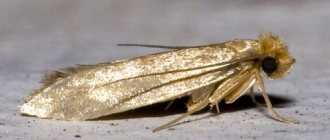How to get rid of moths - hot days have come, and you are increasingly ventilating the apartment by opening the windows wide open. But along with the next gust of cool wind, an unwanted guest may fly in - a moth. And if it’s not difficult to deal with one individual - catch it, and that’s the end of the matter - then with several that have managed to lay eggs, you’ll have to tinker. You can eliminate moths in your apartment using folk remedies.
Does it help?
Lavender can be used in a variety of ways to combat harmful butterflies. And it really helps to eradicate small numbers of moths and prevent them from appearing. This is explained very simply - all insects have plants whose smell they do not like or cannot stand because of their toxicity. For moths, such crops are lavender, mint, geranium and others. But at the same time, these plants are absolutely harmless to humans and have a pleasant aroma.
In rare situations, lavender can cause allergies and, if used correctly, does not cause any side effects. Therefore, its use is safe even in homes where children live.
Typically, this crop is used to prevent the appearance of a pest . If the insect has proliferated greatly and there is a large family, first they need to be destroyed using chemicals. Then, to prevent the moths from returning, fragrant lavender bags should be placed in closets or chests of drawers - this smell will repel both adult moths and caterpillars.
Mint
Like lavender, this plant has a strong scent .
It is used in a similar way: the dried leaves are laid out in small bags and placed where there should be a large concentration of pests.
From time to time it is recommended to check whether the pouch is exhausted. If this happens, replace it with another one with fresher dried leaves. To increase efficiency, you can place them in the wardrobe in the pockets of sweaters, coats, fur coats and jackets .
How to use?
Both dried lavender twigs or flowers and its essential oil (often used in many industrial products aimed at getting rid of pests) will equally help to get rid of harmful insects.
Dried
If the herbaceous plant is grown in the garden or grows nearby, then it should be cut and dried in the summer (it is better to start collecting 2 weeks after the start of flowering - then the crop will have the most intense aroma).
You can dry lavender both in the apartment (for example, on the balcony) and on the street. To do this, a fresh bouquet needs to be divided into several bunches , tied and hung to dry.
If you don’t want to make the preparations yourself, you can purchase already dried grass.
When the plant is prepared, it can be made into a fragrant sachet, which is then placed :
- in closets with clothes;
- in chests of drawers;
- in dressing rooms;
- in chests, etc.
Lavender bags can be placed on shelves between piles of clothes and hung in different places in the closet.
To make such a fragrant product, you will need:
- two square pieces of fabric, with a side of 10 cm;
- threads, needle and scissors;
- crushed dried lavender.
Now you should sew two pieces of fabric together (from the wrong side), leaving a small hole - through it you will need to lay the dried grass. Now the hole should be sewn up and the fragrant sachet is ready.
There is an easier way to make a lavender bag. To do this, you will need a small square piece of fabric, in the center of which the dried crop is laid out. Then the 4 corners are gathered in the center and tied with ribbon, rope or thread. You can also place the grass in special porous bags.
The validity period of such products is approximately 2 months . After this time, they cease to be fragrant and therefore require replacement.
You don't have to make sachet - you can just hang bunches of dried lavender in your closets. For a longer lasting effect, other strong-smelling herbs can be added to this crop. But in this case, it is necessary to ensure that the inflorescences do not fall off onto clothes or bedding.
To repel moths, you can place fragrant, dry bouquets of lavender in all rooms - they will not only prevent the appearance of insects, but will also become an excellent interior decoration. In addition, this herbaceous plant is safe for both humans and pets.
You should choose strong-smelling branches, otherwise there will be no guaranteed effect from using the crop.
In the form of essential oil
Essential oil is no less effective in fighting moths.
The easiest way to use it is to place open vessels directly on the cabinet shelves. To protect clothes, you can spray them with a decoction of lavender flowers, which is prepared as follows:
- Place 1 tablespoon of lavender inflorescences in a container.
- 400 ml of boiling water is poured.
- Close the lid tightly (so that the essential oil does not evaporate) and leave for 10-15 minutes.
You should not spray clothes with pure ether, because if it contains an additive in the form of palm or sunflower oil, noticeable stains will remain on things that cannot be removed.
A proven method used to combat moths for several centuries is the production of sachets. It's very easy to make it yourself. For this you will need :
- linen fabric (for one product you will need a square with sides of 10 cm);
- lavender oil;
- odorless edible sea salt (or woolen threads);
- ribbon or thread and needle.
To make a sachet you need:
- Place salt or threads in the middle of the fabric.
- Sprinkle with lavender oil (7-10 drops are enough).
- Sew the fabric along the edges to create a pillow or connect its ends, tying tightly with ribbon.
The fragrant sachet is ready. It is laid out on shelves in closets, dressing rooms, chests of drawers with bed linen.
You don't have to use only lavender oil to repel moths. You can add a couple of drops of citrus essential oil or rose, geranium, pine, and mint oil.
Another effective way to combat harmful insects is to use a spray with lavender essential oil. To do this you will need :
Combine lavender ether (10 drops) with ethyl alcohol (10 ml).- Pour the solution into a container with a spray bottle.
- Spray linen drawers and cabinet shelves with the resulting spray.
Lavender oil can be added to water when washing floors or wiped furniture with such fragrant water. Thanks to this, the pleasant smell of lavender will reign in the room for a long time, which will protect the house from moth invasion.
Where do moths live?
Clothes moths reveal themselves by the appearance of small through holes in textiles. She has good taste - she prefers natural fabrics like wool, cashmere, silk. Signs of food moths are even less pleasant - you will find tiny moth eggs or even hatched larvae in flour, grains, cereals and other products that are not stored in the refrigerator.
Secondary signs of moths appearing in an apartment are various cobwebs, short white fluff, and lumps of unknown origin. They remain after the pupa transforms into a moth. But still, the main sign that we will focus on is moth eggs.
An adult moth does not lay eggs just anywhere - it creates specific nests. Their walls usually consist, like those of birds, of any “available materials”: villi, scales, dust, even the feces of the insects themselves. It is not difficult to identify the nest - it is a light “clump”, as if molded from softened oatmeal. In size it usually does not exceed 2–3 cm in diameter.
Once you find the nest, you can immediately destroy the main threat
Where should such nests be looked for? Clothes moths usually create nests in the folds of some clothing made from natural fabric. She doesn’t disdain upholstery either. Small nests can even be found in the seams of textiles. Food moths choose other places - namely bags with flour, cereals, dried fruits. The nest may also be in a hermetically sealed jar - perhaps the purchased products have already been infected with eggs.
If you find a moth nest, you must dispose of it immediately. Wearing gloves, place the item that the moth has chosen in a plastic bag and wrap it tightly. Dispose of the nest in the yard without delay - no need to put the nest in your own trash can.
If a moth has chosen a piece of clothing that is very dear to you as a nesting site, then you can save it. Scoop the nest from the clothing into a bag. Be careful not to leave any eggs on it. Then take the damaged item to the dry cleaner.
Advantages and disadvantages
The advantages of using lavender culture as a means of combating harmful butterflies include:
- strong but pleasant smell that lasts a long time;
- placing lavender pads and dried bouquets not only repels moths, but also fills things with a delicate aroma;
- long lasting effect;
- safe for humans and pets;
- almost does not cause allergies and various adverse reactions (unlike chemicals);
- environmental friendliness of the method;
- ease of use: just place ready-made or self-made pads in cabinets - and effective prevention of moths is guaranteed.
However, this method has one drawback - if there are a lot of moths in the house, then it will take a lot of time to completely get rid of them using only lavender. The insects will not fly away immediately.
Traditional remedy
The first thing that comes to mind is, of course, naphthalene. The product has proven effectiveness over generations, is used traditionally and has even given rise to the idiom “smells like mothballs,” i.e. strongly associated with moths.
Modern research has proven that naphthalene is dangerous not only for gray pests that devour fur coats and natural dresses, but also for humans. Despite this fact, a folk remedy with a characteristic odor is still widely used in everyday life. Whether to put yourself and your family in danger for the sake of a quick and effective method of fighting moths is everyone’s personal choice.
horse chestnut
It turns out that chestnut protects well from insect pests. Its seeds should be collected in late autumn.
After drying them in the oven (raw chestnuts quickly become moldy), place them on shelves in the cupboards. You won't need bags here.
Chestnut has several advantages:
- The fruits are easy to collect and just as easy to arrange;
- They act effectively and do not have a strong aroma ;
- The fruits are quite large in size, so they are not capable of littering the apartment.
Essential oils
Essential liquids are an excellent and very effective folk remedy for repelling pests.
fir, eucalyptus, rosemary oil, as well as patchouli, lemongrass and citronella oil are actively used .
Mode of application:
- Rinse the floor with water, after adding a few drops of essential liquid;
- Wipe the shelves and surfaces where moths may accumulate with oil;
- Lay out the swabs soaked in liquid;
- Spray cabinets and rooms;
- Place open bottles of anti-pest oils in wardrobes, kitchen cabinets and bedside tables.
Naphthalene
Perhaps the most famous and most effective folk remedy for moths is naphthalene.
IMPORTANT! today it is not recommended for residential buildings .
But mothballs are still popular and help get rid of butterflies and insect larvae that cannot stand its pungent smell. Bags of mothballs are usually placed between stacks of clothes on the shelves of wardrobes.
Naphthalene is not able to fight food moths (more about fighting kitchen moths), only clothes moths, since food actively absorbs odors. Therefore, it would be unwise to expose food to spoilage. But there are many modern substitutes for naphthalene against pests that are no less effective.
Modern chemical compounds, which are freely sold in specialized stores, are always ready to help folk remedies for moths in the house.
But you shouldn’t neglect your grandmother’s old methods either, which, as practice shows, do not lose their effectiveness over the years and can be used when really necessary.
So, we told you how to fight moths using folk remedies, described flowers and plants that repel the pest, and also gave advice on how to remove moths from the kitchen using folk remedies?
NOTE! Find out where moths come from in an apartment? Did you know that wax moth exists, and the tincture of its larvae has many medicinal properties.
Geranium
The fight against small gray butterflies that have settled in the house is not always active and involves the use of means specially prepared for this. There are also passive ways. Often it is enough to place an indoor flower on the windowsill, like an ordinary geranium .
Many insects cannot tolerate the smell of this plant. If the apartment is large, get several bushes. Place one pot in each room. Geranium is equally effective against both kitchen and clothes moths.
Always keep live flower bushes in your apartment. Periodically open kitchen cabinets, wardrobes and bedside tables, ventilating them once every few days.
Scented herbs
Insects are repelled by bunches of wild or cultivated fragrant herbs. Among them, the most effective means are the following:
- Sagebrush;
- Tansy;
- Chamomile;
- Valerian;
- Marigold;
- Carnation.
Other folk methods and means to repel annoying pests:
- Camphor . Soak swabs in it and place them in places where butterflies accumulate.
- A combination of lemon and cloves . The buds of a spicy plant are stuck into half a lemon and suspended on a strong thread above the shelves with things.
- Pieces of cedar twigs and wood are also not carried by insects. Place them in wardrobes where fur coats hang. You can also use cedar needle oil for this purpose.
- black pepper (peas) using the same method .
- Residents claim that sometimes gray butterflies are repelled by the smell of fresh newspapers . But experts consider this method rather dubious.
Advice! To prevent insects from infesting the kitchen, the best solution would be to store cereals in closed containers or tightly tied bags. Before storage, clean outer clothing and put plastic covers on it.
Do not forget to regularly ventilate the apartment and constantly clean it using disinfectants. Moths are afraid of low and high temperatures. So washing in hot water, frying clothes in the open sun or airing in frosty air makes it possible to get rid of females, eggs of pests or their larvae.
By the way, the larvae and eggs are attached to clothes very weakly, so they fall to the floor at the slightest shaking. For this reason, items that are constantly worn are rarely damaged. Those who hang in wardrobes for a long time and wait in the wings suffer the most.
Fragrant tobacco
Tobacco is another effective folk method against gray butterflies. Fragrant tobacco is usually used as a houseplant, but as for smoking tobacco, it is better to use it in the form of small dry leaves, as in the cigarettes we are used to.
Place regular tobacco in bags and place inside pieces of furniture. Don't forget to ventilate your wardrobe periodically.
Attention! Do not use tobacco to protect clothing from moths. Things soaked in it will lose their attractiveness.
The secret to efficiency
A common pest in the kitchen is food moths. The butterfly enters the room through open windows, larvae, eggs - along with fruits, products, backfill from the store. The butterfly itself is not dangerous for a person and his home. She doesn't eat anything, she doesn't spoil anything. But, once in the house, she looks for a favorable place to lay eggs. It should be dry, dark, and have plenty of food.
The moth lives for about 2 weeks, during which time the butterfly lays about a hundred eggs. After a few days, larvae appear - small, voracious caterpillars. Gradually they are populated in almost all food supplies in the kitchen. Moth larvae feed on food and practically do not leave hot spots; only when they are heavily infested, they travel around the apartment. After 1-2 months they pupate and moths appear.
On a note!
To find a suitable place for larvae with an abundance of food, butterflies are guided by their sense of smell. Smells connect the insect with the outside world. Persistent strong aromas prevent the female from finding her way around the area and finding a place to lay eggs. In such a situation, the moth either flies away through open windows or dies without leaving any offspring.
What is he afraid of?
To understand what the kitchen moth is afraid of, you should determine its habitat. In the kitchen, the parasite can be found in cereals, flour, and any dry food products. To eliminate larvae, you should carefully review all packages of cereals, seasonings and similar substances.
It is important to get rid of all contaminated food items, otherwise others will gradually become affected.
Shelves can be treated with laundry soap or essential oils. This will be safe for the health of household members. Also, to repel, bunches of fragrant herbs such as mint and lavender are laid out. Spicy odors do not kill parasites, but only force them to look for another home.
Also, in the absence of lavender and mint, use bay leaf and garlic against kitchen moths.
But what you should be more afraid of is not flying individuals, but their larvae, which hide in secluded dark places and spoil food and things.
Some more helpful tips?
Place dry foods that you plan to store for a long time in the freezer for a week. The reason is simple: if you have purchased products contaminated with moth eggs, keeping them in the freezer for a week will kill them, because at the initial stages, moth eggs are invisible to the naked eye and are harmless.
- To minimize the risk of dry foods becoming infected with moths, they should be stored in plastic, hermetically sealed containers or hermetically sealed plastic bags. Please note that it is recommended to use several bags placed on top of each other, and do not use elastic bands or clips to close them.
- It is not recommended to purchase dry products in damaged packaging, because in this case the risk of them becoming infected with moths will be maximum.
Our employees have extensive experience in combating clothes and kitchen moths and are ready to carry out prompt, safe and affordable treatment of your home!
- < Back
- Forward >











